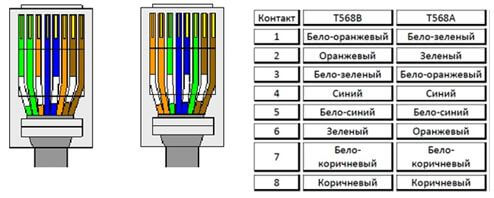Answer the question
In order to leave comments, you need to log in
What is the most popular twisted pair crimping standard?
I always crimp according to standard A. To illustrate, a picture from a neighboring question: 
But when you have to deal with networks that I didn’t originally make, or with patch cords that I didn’t crimp, then there are any schemes except A. what, it works" - the crimpers probably think), and just in the order of the colors, and in general some unknown schemes.
The question is: Is it so unpopular?
Answer the question
In order to leave comments, you need to log in
The patch cord with both the T586A and the T568B is a "crossover" cable that was used before the advent of automatic MDI/MDIX.
Option B has been the de facto standard for 20 years.
Option A could be found in some outlets.
According to the specification, transmission is on 1-2, reception is on 3-6.
Therefore, if you crimp a long cable at random, you can get into a pair that will have wires of different lengths
A at 100 meters, the difference can be up to 1-2 meters between different in pairs due to the different number of turns.
This will cause signal timing problems - that is, packet loss, up to and including a broken cable.
On short 1-2 meter patch cords, there should be no problems, but I would re-compress.
I always crimp everything in B, I crimped in A-B for the last time a very long time ago.
Everything I've seen lately, the factory patch cords are crimped B-B.
All sorts of schemes ala "for gigabit, etc." I consider it cunning - the gigabit of the norms also rises to B.
Only circuits A and B are stamped on the sockets and inserts, everything is also crimped according to B. If you make pants, then one socket is B, the second is O \u003d C; Z=K.
At short distances, a prerequisite is that both ends have the same crimp and the pairing 1.1-1.2-2.1-3.2-3.1-2.2-4.1-4.2 matches, and what colors 1,2,3,4 will be is not so important
Didn't find what you were looking for?
Ask your questionAsk a Question
731 491 924 answers to any question